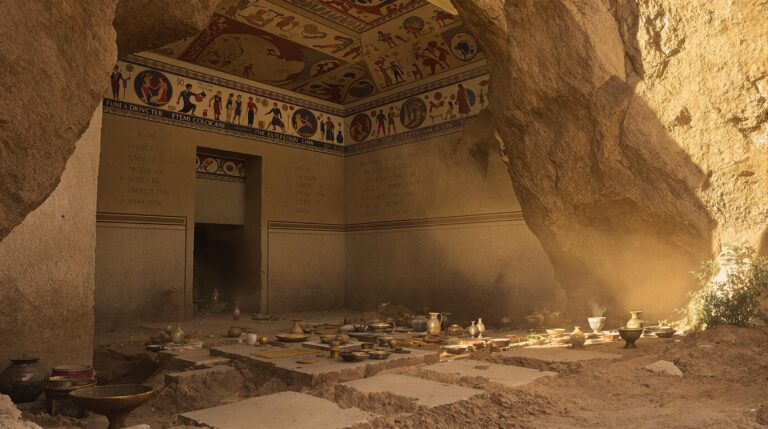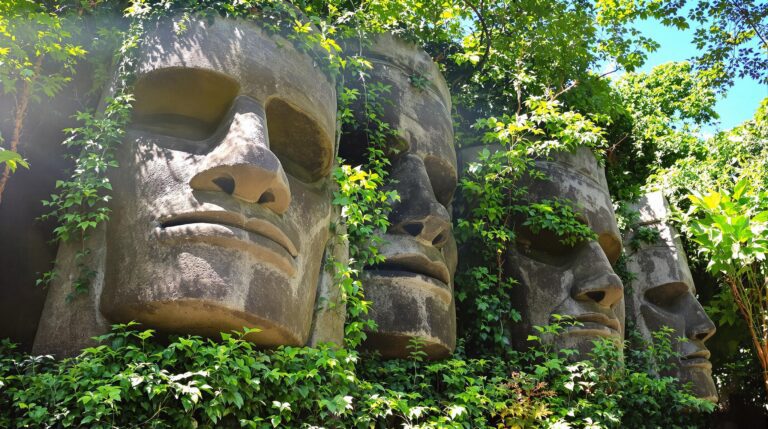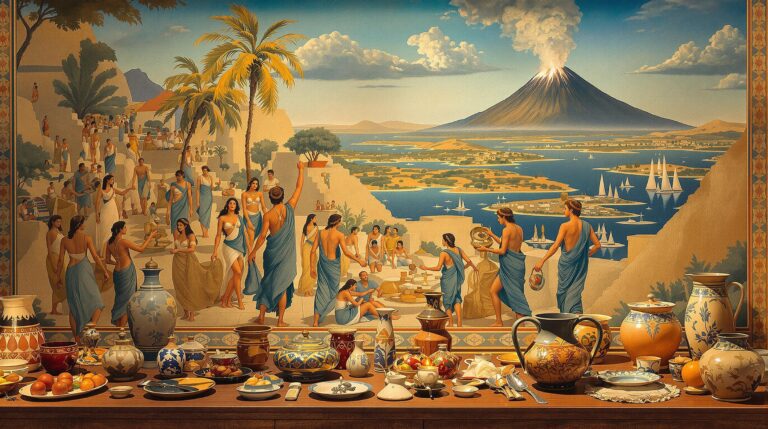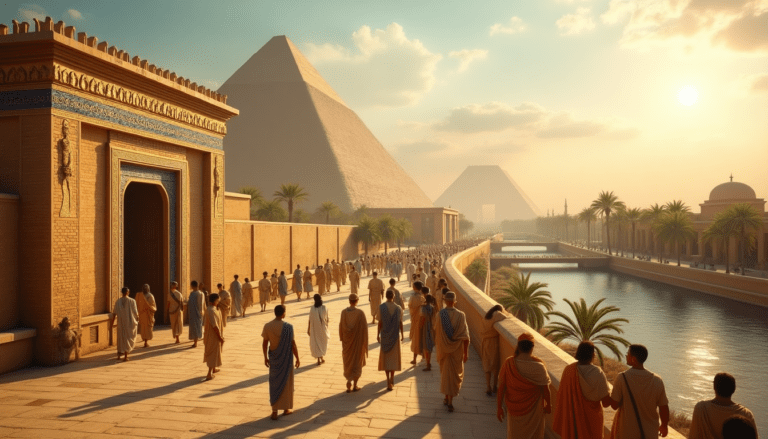Ancient Nubia: The Forgotten Kingdom
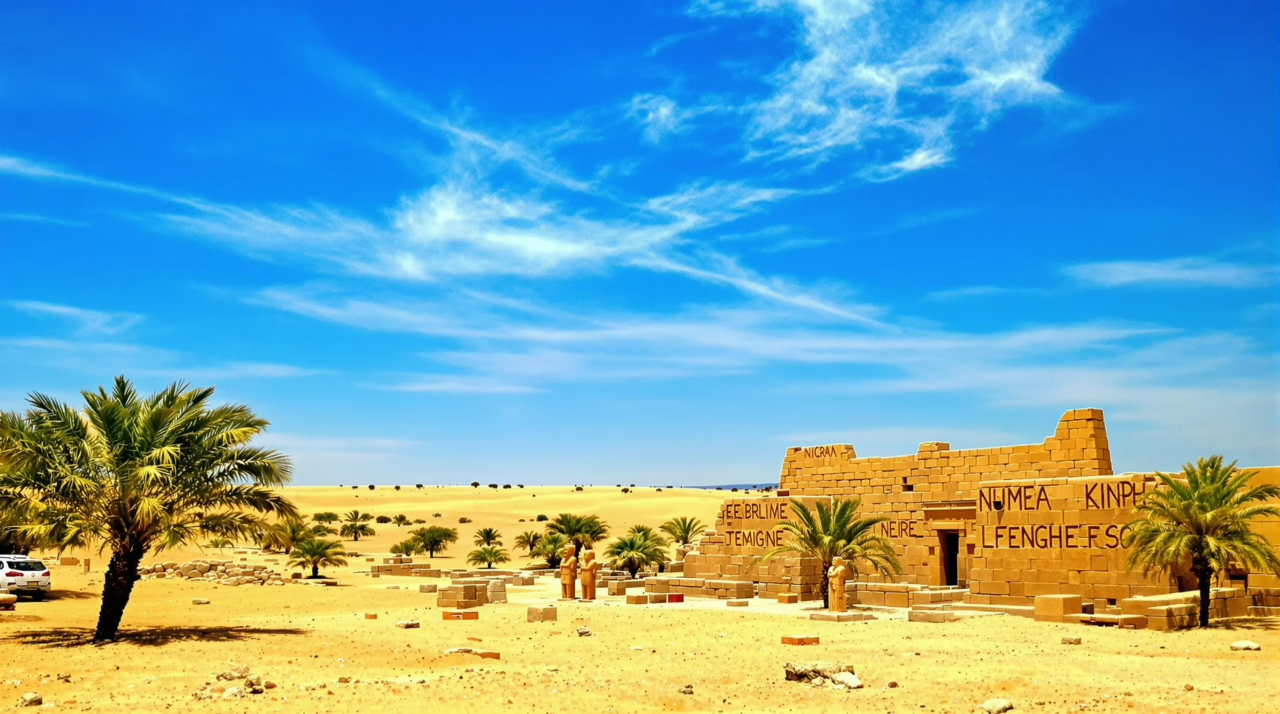
Ancient Nubia remains a largely overlooked chapter in the annals of history. Its powerful kingdoms, particularly Kerma and Kush, crafted a civilization rich in culture and spirituality.
Yet, how did Nubia’s distinct identity evolve amidst the shadows of its more famous neighbor, Egypt?
The remnants of monumental architecture and intricate burial customs offer tantalizing glimpses into a society shaped by trade and divine beliefs. What truths lie beneath the surface of this forgotten kingdom?
TL;DR
Hide- Ancient Nubia, located along the Nile, was a hub of trade and cultural exchange, influencing civilizations like ancient Egypt.
- The Kingdom of Kush, a significant Nubian kingdom, demonstrated rich cultural identity through monumental architecture and unique burial practices.
- Nubia's strategic location facilitated the trade of valuable resources like gold and ebony, enhancing its political and economic importance.
- Women in Nubian society, particularly Kandakes, played crucial roles in leadership and military, challenging traditional gender roles of the time.
- The decline of Meroë led to complex questions about environmental and economic factors, shaping Nubia's lasting legacy and relevance today.
Introduction to Ancient Nubia
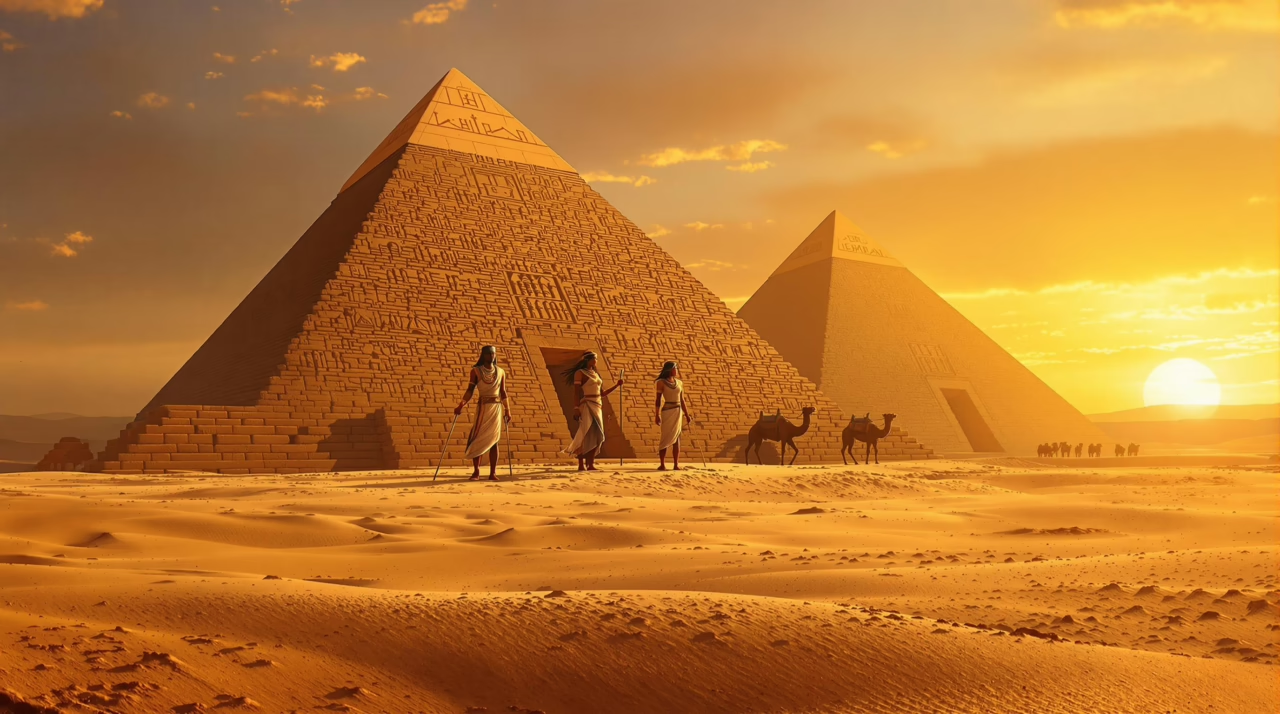
Ancient Nubia, situated along the Nile River’s banks, presents a fascinating geographical landscape that has shaped its historical trajectory.
What timelines encapsulate the rise and fall of its remarkable civilizations?
Understanding these elements invites a deeper exploration into Nubia’s rich cultural heritage and its interactions with neighboring societies.
Defining Nubia’s Geographical Location
Nubia’s geographical location, straddling the crucial corridor between the First and Sixth Cataracts of the Nile, raises intriguing questions about its role in ancient civilization.
This region, rich in natural resources, not only offered sustenance but also held strategic importance that influenced trade and cultural exchange.
How did these geographical features shape the dynamics of power and society in ancient Nubia?
The Land Between the First and Sixth Cataracts of the Nile
Nestled between the First and Sixth Cataracts of the Nile lies a region rich in history and culture, known for its complex interplay of geography and civilization.
This stretch of land, marked by its distinctive topography, invites exploration.
How did the natural barriers shape the societies that flourished here?
What secrets lie within its ancient landscapes, waiting to be uncovered?
Natural Resources and Strategic Importance
Although often overshadowed by neighboring civilizations, the region between the First and Sixth Cataracts of the Nile possesses a wealth of natural resources that greatly contributed to its historical significance.
Rich deposits of gold, fertile lands, and abundant stone quarries not only shaped Nubia’s economy but also underscored its strategic importance, making it a pivotal player in ancient trade and cultural exchanges.
Timeline of Nubian Civilizations
The timeline of Nubian civilizations presents a vibrant mosaic of cultural evolution, beginning with the A-Group and culminating in the powerful Kingdom of Kush.
How did these societies interact with their ancient Egyptian neighbors, and what influences exchanged between them?
Exploring this timeline not only reveals the complexities of Nubian history but also challenges prevailing narratives about ancient African civilizations.
From the A-Group to the Kingdom of Kush
Emerging from the shadows of history, the progression from the A-Group culture to the Kingdom of Kush reveals a complex tapestry of societal evolution in ancient Nubia.
This transformation prompts reflection on:
- The rich cultural exchanges that shaped identities.
- The resilience of communities amid environmental changes.
- The quest for autonomy and power.
- The enduring legacy of Nubian craftsmanship and spirituality.
Interactions With Ancient Egypt and Beyond
As the Kingdom of Kush flourished in the wake of the A-Group culture, its interactions with ancient Egypt and other neighboring civilizations became a defining feature of its historical narrative.
These exchanges encompassed trade, cultural diffusion, and military confrontations, revealing a complex tapestry of influence.
What drove these relationships? Were they rooted in cooperation, rivalry, or a blend of both? The answers remain tantalizingly elusive.
Early Kingdoms and Cultural Identity
The emergence of the A-Group and C-Group societies marks a pivotal moment in Nubian history, igniting questions about their cultural identities and interactions.
How did these early kingdoms, particularly Kerma, shape the social and political landscape of the region?
Examining the artifacts and structures from this era reveals a complex tapestry of influences that contributed to Nubia’s distinct identity.
The A-Group and C-Group Societies
The burial customs and trade practices of the A-Group and C-Group societies reveal intriguing aspects of early Nubian cultural identity.
How did their unique artistic expressions and pottery styles reflect both local traditions and external influences?
Exploring these elements may illuminate the complexities of social structures and interactions within this ancient civilization.
Burial Customs and Early Trade Practices
Burial customs in ancient Nubia reveal profound insights into the cultural identities and societal structures of the A-Group and C-Group societies.
These practices reflect their values and connections to trade, including:
- Elaborate tomb constructions symbolizing status.
- Inclusion of grave goods for the afterlife.
- Evidence of trade networks through imported artifacts.
- Ritualistic practices showcasing spiritual beliefs.
Such customs speak to their enduring legacy.
Artistic and Pottery Styles Unique to Nubia
While exploring the artistic and pottery styles of ancient Nubia, one uncovers a diverse array of cultural identity that distinctly characterizes the A-Group and C-Group societies.
Intricately designed ceramics, adorned with geometric patterns and lively hues, reflect a deep connection to both spiritual beliefs and daily life.
These artifacts reveal not just artistry but also the evolving narratives of a civilization yearning for expression and identity.
Kerma: The First Great Nubian Kingdom
Kerma, recognized as the first great Nubian kingdom, presents a fascinating study of monumental architecture and fortifications that reflect its power and societal organization.
The presence of religious centers and elite tombs raises questions about the spiritual beliefs and hierarchy within this early civilization.
What can the remnants of Kerma’s structures reveal about the cultural identity and aspirations of its people?
Monumental Architecture and Fortifications
As monumental architecture and fortifications began to emerge in ancient Nubia, one might wonder how these structures reflected the cultural identity and political ambitions of the Kerma kingdom.
The grandeur of these constructions evokes profound sentiments:
- A testament to ambition.
- A symbol of unity.
- An expression of sovereignty.
- An enduring legacy of resilience.
Such edifices encapsulated the essence of Nubian identity.
Religious Centers and Elite Tombs
Throughout the early kingdoms of Nubia, numerous religious centers and elite tombs emerged, each serving as a focal point for both spiritual practices and the commemoration of the ruling class.
These sacred spaces reflected the intricate beliefs of the Nubians, intertwining their identities with the divine.
The opulence of the tombs underscored the significance of ancestral reverence, inviting exploration of their cultural legacy and spiritual aspirations.
The Kingdom of Kush
The Kingdom of Kush presents a fascinating narrative of power dynamics, particularly through its two prominent centers: Napata and Meroë.
How did the ascendancy in Napata influence the political landscape of ancient Nubia, and what factors contributed to the eventual shift of authority to Meroë?
Exploring these questions reveals the complexities of Kushite governance and cultural evolution.
Napata: Power Rises in the North
As the Kingdom of Kush emerged from the ancient city of Napata, it wielded significant influence over Egypt, establishing the 25th Dynasty.
This era marked a fascinating confluence of Nubian and Egyptian cultures, where distinct elements began to intertwine, shaping a unique identity.
What factors contributed to this powerful synthesis, and how did it redefine the cultural landscape of the Nile Valley?
Kushite Rule Over Egypt as the 25th Dynasty
While many civilizations rose and fell in the ancient world, the Kushite rule over Egypt during the 25th Dynasty stands out as a remarkable example of cultural exchange and political ambition.
This period is notable for:
- The unification of two powerful cultures.
- Architectural marvels that defied boundaries.
- A resurgence of traditional values.
- The challenge to foreign domination.
What drove this extraordinary ascent?
Cultural Synthesis of Nubian and Egyptian Elements
Emerging from the political and cultural complexities of the 25th Dynasty, the Kingdom of Kush in Napata became a focal point for the synthesis of Nubian and Egyptian elements.
This blend manifested in art, architecture, and religious practices, reflecting a rich dialogue between two civilizations.
How did these interactions reshape identities and foster a unique cultural legacy that still resonates in contemporary discussions of freedom and heritage?
Meroë: The Southern Shift in Power
As the Kingdom of Kush shifted its center of power to Meroë, a fascinating transformation took place, marked by advancements in iron production that spurred economic prosperity.
The construction of grand pyramids and palaces during this period raises questions about the cultural and political motivations behind such monumental undertakings.
Additionally, the emergence of writing systems invites an exploration of how communication and governance evolved in this lively southern capital.
Iron Production and Economic Prosperity
Iron production in ancient Nubia, particularly during the Kingdom of Kush, transformed the region into a formidable economic powerhouse.
This shift yielded profound implications for its society and culture:
- Empowerment through resource control
- The birth of a thriving trade network
- Strengthening of political authority
- Catalyzing innovation and craftsmanship
Such advancements illuminated the path toward autonomy and prosperity, echoing the aspirations of its people.
Pyramids, Palaces, and Writing Systems
While the Kingdom of Kush flourished, the architectural marvels of pyramids and palaces in Meroë became symbols of its newfound power and cultural identity.
These structures, adorned with intricate carvings, reflected a sophisticated society.
Moreover, the development of writing systems highlighted the kingdom’s intellectual aspirations.
What messages did these monumental creations convey about leadership, spirituality, and the enduring spirit of a lively civilization?
Architecture, Art, and Writing
The architectural marvel of Nubian pyramids and royal tombs invites contemplation of their significance within the Kingdom of Kush.
Coupled with a diverse array of artworks and iconography, these structures reflect a complex cultural identity that seeks to convey deeper meanings.
Meanwhile, the enigmatic Meroitic script remains a tantalizing puzzle, beckoning scholars to reveal the mysteries of Nubian writing and its role in preserving history.
Nubian Pyramids and Royal Tombs
The Nubian pyramids present a striking contrast to their Egyptian counterparts, both in architectural design and cultural significance.
How do the unique burial practices and ritual symbolism of the Nubians reflect their distinct identity within the ancient world?
An exploration of these differences invites a deeper understanding of the intricate mosaic of Nubian heritage.
Differences From Egyptian Pyramid Designs
Although both Nubian and Egyptian pyramids served as monumental tombs for royalty, significant differences in their architectural design and artistic expression reveal a unique cultural identity.
Nubian pyramids are particularly:
- Smaller in scale, yet more numerous.
- Built with steep angles, creating distinct silhouettes.
- Decorated with intricate carvings reflecting local beliefs.
- Positioned in clusters, symbolizing communal reverence.
These features illuminate Nubia’s rich heritage and autonomy.
Burial Practices and Ritual Symbolism
Examining the burial practices of ancient Nubians reveals a tapestry of ritual symbolism intricately woven into their architectural and artistic expressions.
The Nubian pyramids, with their distinct angles and orientations, served not merely as tombs but as cosmic gateways.
Intricate wall carvings and funerary items reflect beliefs in the afterlife, illustrating a profound connection between the living and the spiritual domains they sought to navigate.
Artworks and Iconography
The artistry of ancient Nubia reveals a fascinating interplay of materials, particularly gold, bronze, and ivory, which were skillfully employed in the creation of intricate artifacts.
How do these choices in craftsmanship reflect the societal values and beliefs surrounding kings, queens, and deities?
The iconography present in Nubian artworks invites contemplation on the cultural significance of these figures within their historical context.
Use of Gold, Bronze, and Ivory in Craftsmanship
How did the ancient Nubians elevate their craftsmanship through the use of gold, bronze, and ivory? Their exquisite artistry manifested in:
- Intricate jewelry that told stories of status and beauty.
- Sculptures portraying lifelike figures, capturing human emotion.
- Decorative items that adorned daily life with elegance.
- Functional tools that merged practicality with artistry.
These materials symbolized not just wealth, but a profound connection to identity and heritage.
Depictions of Kings, Queens, and Deities
In ancient Nubia, the elevation of craftsmanship through materials such as gold, bronze, and ivory extended beyond mere adornment and utility, influencing the portrayal of rulers and divine figures within their society.
These depictions, rich in symbolism and detail, invite contemplation on power and spirituality.
How did these artistic expressions shape perceptions of authority and the divine in an era often overshadowed by history?
The Meroitic Script and Its Mystery
The Meroitic script, an enigmatic writing system of ancient Nubia, presents a unique blend of phonetic and ideographic elements that reflect the culture’s complexity.
Scholars have long grappled with the challenge of deciphering this script, raising questions about the historical context and significance of its use.
As investigations continue, what insights might emerge from the interplay of architecture, art, and this elusive form of communication?
Characteristics of the Indigenous Writing System
Meroitic script, a fascinating aspect of ancient Nubian civilization, presents a unique blend of linguistic and artistic elements that continue to intrigue scholars.
Its characteristics evoke wonder and curiosity, highlighting the depth of human expression:
- Unique phonetic structure
- Artistic hieroglyphs
- Symbolic representation of culture
- Connection to sacred texts
These features invite contemplation on the complexities of communication in ancient societies.
Efforts Toward Decipherment
While the allure of the Meroitic script captivates scholars, the quest for its decipherment remains fraught with challenges that intertwine architecture, art, and writing.
The script’s elusive symbols, often found within monumental inscriptions, evoke a persistent intrigue. Each discovery invites deeper inquiry, yet the interplay of cultural context and linguistic structure complicates understanding, leaving a tantalizing mystery that urges further exploration into Nubia’s past.
Trade Networks and External Relations
In considering the trade networks of ancient Nubia, one must ponder how the region’s rich resources, including gold and ebony, shaped its external relations.
The intricate web of commerce not only facilitated the exchange of exotic goods but also influenced military conflicts and political alliances with neighboring cultures.
How did these dynamics contribute to Nubia’s status as a pivotal player in the ancient world?
Gold, Ebony, and Exotic Goods
Nubia emerged as an essential conduit for the exchange of precious resources, particularly gold and ebony, to neighboring Egypt and beyond to the Mediterranean.
The intricate trade routes, stretching across the Red Sea and into the heart of Africa, reveal a complex network of economic interactions that shaped regional dynamics.
What implications did these exchanges have on Nubia’s external relations and its standing in the ancient world?
Nubia as a Supplier to Egypt and the Mediterranean
As trade routes crisscrossed the ancient world, one might wonder how Nubia emerged as an essential supplier of prized commodities to Egypt and the broader Mediterranean region.
The allure of Nubia’s offerings sparked connections that transcended borders, including:
- Gleaming gold that adorned royalty
- Rich ebony that whispered of luxury
- Enigmatic spices that tantalized the senses
- Exotic animals that captivated imaginations
Trade Routes Across the Red Sea and into Africa
While the allure of Nubia’s resources captivated neighboring civilizations, the intricate trade routes across the Red Sea and into the heart of Africa played a pivotal role in facilitating economic exchange.
These pathways not only transported gold and ebony but also enabled the flow of exotic goods, ideas, and cultures, weaving a complex web of connections that shaped the ancient world’s economic landscape.
Military Conflicts and Political Alliances
Ancient Nubia’s military engagements with powerful neighbors such as Egypt, Assyria, and Rome raise intriguing questions about the region’s geopolitical strategies.
How did these conflicts shape political alliances and influence trade networks, particularly through strategic marriages that bolstered regional power dynamics?
The interplay of warfare and diplomacy in Nubia reveals a complex tapestry of relationships that extended far beyond its borders.
Battles With Egypt, Assyria, and Rome
Although Nubia’s rich culture and strategic location facilitated robust trade networks, it also positioned the region as a focal point for military conflicts with powerful neighbors, particularly Egypt, Assyria, and Rome.
These encounters shaped Nubia’s history, highlighting:
- The relentless pursuit of autonomy.
- The sacrifices of the Nubian warriors.
- The quest for cultural identity.
- The enduring legacy of resistance against oppression.
Strategic Marriages and Regional Power Dynamics
The intricate tapestry of Nubian history reveals not only a struggle for autonomy against formidable adversaries but also a sophisticated approach to regional power dynamics through strategic marriages.
These unions often forged alliances with neighboring kingdoms, enhancing trade networks and diplomatic relations.
Analyzing these connections uncovers how Nubians wielded matrimonial ties as tools of influence, steering military conflicts and asserting their sovereignty on a broader stage.
Women in Nubian Society
In ancient Nubian society, the prominence of women, particularly the Kandakes or Queen Mothers, invites a closer examination of their influential roles.
How did these powerful figures shape both the social fabric and religious practices of their time?
Additionally, what implications did their leadership have on the perception of women in a mainly patriarchal world?
The Role of Kandakes (Queen Mothers)
The role of Kandakes in ancient Nubian society raises intriguing questions about the intersection of gender and power.
These queen mothers not only wielded military leadership but also engaged in significant diplomatic negotiations, shaping the political landscape of their time.
Military Leadership and Diplomatic Authority
While often overshadowed by their male counterparts, the Kandakes of ancient Nubia wielded significant military leadership and diplomatic authority that shaped the socio-political landscape of their time.
Their influence evokes contemplation on:
- The courage to lead armies into battle.
- The wisdom in forging alliances.
- The resilience against foreign threats.
- The legacy of matriarchal strength in governance.
What else remains hidden in their stories?
Notable Historical Figures and Their Influence
As the sun set over the ancient landscapes of Nubia, the stories of the Kandakes—powerful queen mothers—emerged as pivotal to understanding the intricate tapestry of Nubian society.
These formidable women wielded significant political and spiritual influence, shaping decisions and maintaining stability. Their leadership highlighted the essential role of women in governance, challenging contemporary narratives and affirming the importance of equality within this rich historical context.
Social and Religious Influence of Women
The social and religious landscape of ancient Nubia reveals intriguing insights into the influence of women, particularly through their artistic depictions and burial practices.
These representations often highlight a matrilineal framework that suggests women held pivotal roles in royal succession and societal structure.
What can these elements tell us about the broader implications of female authority and reverence in Nubian culture?
Depictions in Art and Burial Significance
Artistic representations and burial practices in ancient Nubia reveal profound insights into the role of women within that society.
These depictions evoke deep emotions surrounding their significance:
- Women adorned with intricate jewelry, symbolizing power and status.
- Scenes of maternal nurturing, showcasing life’s continuity.
- Elaborate tombs reflecting spiritual reverence.
- Artistic expressions of female deities, illustrating divine influence.
Such elements underscore the complex tapestry of women’s societal roles.
Matrilineal Aspects of Royal Succession
Although often overshadowed by their male counterparts, women in ancient Nubian society played an essential role in the intricacies of royal succession, particularly through matrilineal lines.
This system not only guaranteed the continuity of royal bloodlines but also elevated women’s status, allowing them to wield significant social and religious influence.
How did these practices shape the broader cultural landscape of Nubia? Such questions beckon exploration.
Religion and Spiritual Beliefs
The spiritual landscape of ancient Nubia reveals a diverse array of deities, some shared with neighboring cultures, while others were distinctly Nubian in nature.
Temples and sacred sites scattered throughout the region stand as monuments to the lively religious practices that defined Nubian identity.
What can these structures and beliefs tell us about the values and societal norms of the Nubian people?
Gods Shared and Unique to Nubia
In exploring the religious landscape of Ancient Nubia, one encounters a fascinating interplay between Egyptian deities and indigenous gods that embody the region’s unique cultural identity.
The adaptations of these shared gods—particularly those associated with fertility, war, and the sun—invite questions about the societal values and environmental influences that shaped Nubian spirituality.
How did these divine figures reflect both a connection to neighboring cultures and a distinct Nubian ethos?
Adaptations of Egyptian Deities
As Nubia engaged with Egyptian culture over centuries, the adaptation of deities became a fascinating interplay of belief systems, where gods were not merely borrowed but transformed.
This phenomenon raises questions about identity, power, and spirituality:
- Merging of attributes
- Cultural resonance
- Evolving mythologies
- Spiritual autonomy
Such adaptations reflect the dynamic nature of faith and the quest for understanding within a shared world.
Indigenous Gods of Fertility, War, and the Sun
Numerous indigenous gods of fertility, war, and the sun flourished in Nubian spirituality, each embodying distinct cultural narratives and values.
These deities, revered for their roles in agriculture, protection, and life-giving energy, reflect a society deeply connected to nature and human experience.
How did these divine figures shape Nubian identity? Their worship reveals a complex interplay of power, reverence, and community resilience.
Temples and Sacred Sites
Jebel Barkal stands as a remarkable representation of the spiritual landscape of ancient Nubia, beckoning inquiry into its profound significance.
What roles did the priesthood play in shaping the rituals and practices that defined this sacred site?
Exploring these elements reveals a complex interplay between belief, power, and the divine in Nubian society.
Jebel Barkal and Its Spiritual Importance
Nestled in the heart of Nubia, the striking silhouette of Jebel Barkal rises dramatically against the desert landscape, inviting contemplation of its profound spiritual significance.
This sacred site evokes deep reverence for:
- The ancient connection between earth and the divine.
- The palpable energy coursing through its sacred stones.
- The whispers of forgotten rituals.
- The enduring quest for enlightenment and freedom.
Priesthood Roles and Ritual Practices
In the intricate tapestry of ancient Nubian spirituality, the priesthood emerged as an essential thread, weaving together the sacred and the mundane.
Tasked with conducting rituals and maintaining temples, priests acted as intermediaries between the divine and the people. Their practices, rich in symbolism and intention, fostered communal identity and spiritual connection, illuminating the profound ways in which faith shaped Nubian society.
Decline and Legacy
The decline of Meroë raises intriguing questions about the factors contributing to its gradual fade from prominence.
What role did environmental changes, trade dynamics, and cultural shifts play in this ancient civilization’s downfall?
In addition, the rediscovery of Nubia through modern archaeology invites an exploration of how contemporary interpretations shape our understanding of its lasting legacy.
The Slow Fade of Meroë
The decline of Meroë raises intriguing questions about the interplay between environmental pressures and economic strains that may have contributed to its downfall.
As shifting trade routes began to redefine regional commerce, internal challenges further complicated the kingdom’s stability.
What factors ultimately precipitated the slow fade of this once-thriving center of Nubian culture?
Environmental Pressures and Economic Strains
As environmental pressures mounted in ancient Nubia, the city of Meroë faced significant economic strains that ultimately contributed to its decline.
The fading glory of this once-thriving kingdom raises poignant questions about resilience and survival:
- Diminished agricultural yields
- Scarcity of essential resources
- Erosion of trade networks
- Social unrest and migration
Can a civilization endure when its lifeblood runs dry?
Shifting Trade Routes and Internal Challenges
While external trade routes once flourished, the gradual shift in their trajectories became a critical factor in the decline of Meroë.
As neighboring powers redirected commerce, internal challenges intensified, straining resources and weakening governance.
This decline, marked by dwindling trade and social unrest, raises profound questions: What legacy remains of this once-thriving kingdom, and how did its people respond to their changing world?
Rediscovery and Modern Archaeology
The resurgence of interest in Nubia has been shaped by the efforts of both European and African scholars, whose excavations have unearthed a wealth of artifacts and insights.
This collaborative exploration raises questions about the cultural and historical significance of Nubia, often overshadowed by its more prominent neighbors.
How has this newfound recognition influenced the understanding of Nubia’s legacy in the broader context of ancient civilizations?
Excavations by European and African Scholars
Excavations in ancient Nubia, driven by the ambitions of both European and African scholars, have revealed a complex tapestry of history marked by cultural exchange and innovation.
These discoveries evoke profound reflections on:
- The resilience of Nubian civilization.
- The interconnectedness of ancient cultures.
- The treasures of forgotten knowledge.
- The urgent need for preservation and recognition.
Such findings inspire a quest for understanding and freedom.
Global Recognition of Nubia’s Historical Value
As interest in ancient civilizations surged, Nubia emerged from the shadows of historical neglect, revealing a wealth of cultural significance that had long been overlooked.
Modern archaeology rediscovered its monumental temples, intricate artifacts, and rich traditions, prompting scholars and enthusiasts to re-evaluate Nubia’s role in world history.
This renewed recognition not only honors the past but also inspires a broader understanding of human civilization’s interconnectedness.
Continuing Impact on African Identity
The enduring influence of Ancient Nubia on contemporary African identity raises intriguing questions about cultural pride and historical reclamation.
How does the representation of Nubian heritage in museums and media shape perceptions of identity among modern African communities?
This exploration invites a deeper understanding of how the past continues to resonate in the present.
Cultural Pride and Historical Reclamation
The legacy of Nubia continues to shape modern African narratives, prompting a resurgence of cultural pride among communities.
How are contemporary preservation efforts and educational programs fostering a deeper understanding of Nubia’s historical significance?
This exploration raises critical questions about identity, heritage, and the ongoing reclamation of African histories.
Nubia’s Influence on Modern African Narratives
Nubia, often overshadowed by its more famous neighbor Egypt, has emerged as a crucial touchstone in the modern African narrative, inspiring a profound sense of cultural pride and historical reclamation among contemporary African societies.
- Rediscovery of ancient legacies
- Empowerment through shared ancestry
- Art and literature reflecting Nubian ideals
- Unity in diversity across the continent
Preservation Efforts and Educational Programs
While many might overlook the significance of Nubia in the broader context of African heritage, ongoing preservation efforts and educational programs are illuminating its rich history and cultural contributions.
These initiatives not only safeguard archaeological sites but also foster a deeper understanding of Nubian identity, encouraging cultural pride and historical reclamation among contemporary Africans seeking connection to their ancestral roots and narratives.
Ancient Nubia in Museums and Media
The portrayal of Ancient Nubia in museums and media raises critical questions about the representation and ownership of cultural artifacts.
As exhibitions showcase these treasures, they spark debates regarding the rightful custodianship of Nubian heritage and its implications for contemporary African identity.
How do these narratives shape perceptions of Nubia’s legacy in the broader dialogue of cultural pride and historical reclamation?
Artifacts, Exhibitions, and Representations Today
Ancient artifacts serve as powerful conduits between the past and the present, illuminating the rich cultural tapestry of Nubia. They evoke a sense of wonder and curiosity, prompting reflections on identity and heritage.
- Intricate pottery revealing daily life
- Majestic statues symbolizing power
- Elaborate jewelry showcasing artistry
- Ancient texts preserving wisdom
Together, these elements inspire a profound connection to African heritage.
Debates Around Cultural Heritage Ownership
How do artifacts from Nubia influence contemporary debates over cultural heritage ownership?
These treasures, often housed in distant museums, raise questions about the rightful custodianship of cultural identity. Scholars and activists argue that returning Nubian artifacts could empower African nations, reclaiming narratives suppressed by colonial histories.
This ongoing discourse challenges the ethics of possession and highlights the need for a more equitable cultural dialogue.
Wrapping Up
In exploring Ancient Nubia, one uncovers a civilization that not only rivaled Egypt but also boasted a staggering 255 pyramids—more than any other African nation.
This architectural legacy prompts a reevaluation of Nubia’s historical significance, revealing a complex society rich in culture and innovation.
As interest in Nubian heritage grows, one must wonder how these ancient narratives will reshape contemporary African identity, inviting a deeper understanding of the past and its enduring influence on the present.
